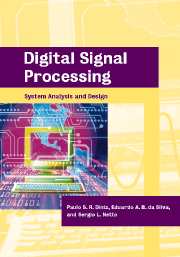Book contents
- Frontmatter
- Contents
- Preface
- Introduction
- 1 Discrete-time systems
- 2 The z and Fourier transforms
- 3 Discrete transforms
- 4 Digital filters
- 5 FIR filter approximations
- 6 IIR filter approximations
- 7 Finite-precision effects
- 8 Multirate systems
- 9 Filter banks and wavelets
- 10 Efficient FIR structures
- 11 Efficient IIR structures
- 12 Implementation of DSP systems
- References
- Index
5 - FIR filter approximations
Published online by Cambridge University Press: 05 June 2012
- Frontmatter
- Contents
- Preface
- Introduction
- 1 Discrete-time systems
- 2 The z and Fourier transforms
- 3 Discrete transforms
- 4 Digital filters
- 5 FIR filter approximations
- 6 IIR filter approximations
- 7 Finite-precision effects
- 8 Multirate systems
- 9 Filter banks and wavelets
- 10 Efficient FIR structures
- 11 Efficient IIR structures
- 12 Implementation of DSP systems
- References
- Index
Summary
Introduction
In this chapter, we will study the approximation schemes for digital filters with finiteduration impulse response (FIR) and we will present the methods for determining the multiplier coefficients and the filter order, in such a way that the resulting frequency response satisfies a set of prescribed specifications.
In some cases, FIR filters are considered inefficient in the sense that they require a high-order transfer function to satisfy the system requirements when compared to the order required by digital filters with infinite-duration impulse response. However, FIR digital filters do possess a few implementation advantages such as a possible exact linear-phase characteristic and intrinsically stable implementations, when using nonrecursive realizations. In addition, the computational complexity of FIR digital filters can be reduced if they are implemented using fast numerical algorithms such as the fast Fourier transform.
We start by discussing the ideal frequency response characteristics of commonly used FIR filters, as well as their corresponding impulse responses. We include in the discussion lowpass, highpass, bandpass, and bandstop filters, and also treat two other important filters, namely differentiators and Hilbert transformers.
We go on to discuss the frequency sampling and the window methods for approximating FIR digital filters, focusing on the rectangular, triangular, Bartlett, Hamming, Blackman, Kaiser, and Dolph–Chebyshev windows. In addition, the design of maximally flat FIR filters is addressed.
Following this, numerical methods for designing FIR filters are discussed. A unified framework for the general approximation problem is provided.
- Type
- Chapter
- Information
- Digital Signal ProcessingSystem Analysis and Design, pp. 188 - 253Publisher: Cambridge University PressPrint publication year: 2002

